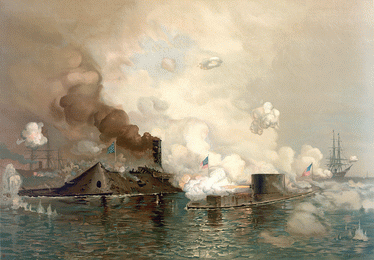The USS Monitor Versus the CSS Virginia


The monstrous vessel left its moorings at near noon Saturday March 8 1862 and moved into the Elizabeth River’s main channel. It was a slow and unwieldy ship, but its ponderous approach coupled with its numerous ports for large guns and its sides were encased in plates of iron presented a darkly foreboding force.
The vessel was the CSS Virginia and its destination that day was the destruction of the Union ships blockading the large water embayment called Hampton Roads. This blockade was strangling foreign supplies from reaching the northern Confederate States. The Virginia’s intention was to destroy the Union ships forming that blockade.
But this day did not start as such; the Virginia’s initial purpose was to make a trial run of the newly constructed vessel. Everything above the waterline was new, even the guns that had yet to be fired. Below the waterline, the ship was older, being the severely repaired remains of the USS Merrimack. Workmen were still aboard: scattered about the ship, checking various problems as they arose.
As the Virginia moved forward toward Hampton Roads, it was joined by two smaller Confederate vessels, CSS Raleigh, and CSS Beaufort and shortly thereafter by three equally small vessels of the James River Squadron: CSS Patrick Henry, CSS Jamestown, and CSS Teaser. They were anxious to watch the slow-moving monster that promised, with its new conceptual design, to advance the Confederate cause by destroying the Union blockade.
The Union fleet facing the Virginia was equally imposing. It consisted of five large warships, the cream of the Union blockading fleet. These included: the sail powered sloop-of-war, USS Cumberland, and the frigate USS Congress, lying off Newport News. and sail / engine powered frigates, USS Minnesota, USS Roanoke, and USS St. Lawrence standing off Fort Monroe.
As the Virginia reached the open waters off Craney Island, Commander Franklin Buchanan, the captain of the Virginia, saw displayed the entire blockading force of Union warships at anchor just off the northern shore.
Buchanan was an aggressive naval officer. What he saw before him was an opportunity. The weather was perfect, just to his rear was an excellent assortment of Confederate warships that could provide excellent fire support. Although the Virginia had been shown to have problems, she was sluggish, slow, and a deep (22’) draft, none of these could be easily corrected. The time to attack was not weeks in the future spent correcting these problems, the time, he realized, was to attack now.
He signaled to the smaller Confederate ships to accompany him in the attack, and after landing the workmen at nearby Craney Island, he headed the Virginia directly at the nearest blockading Union ship, the Cumberland.
The Union ships, on seeing the Virginia and its escort of Confederate ships approach, raised their anchors and rigged for battle.

The important exception to the strength of the two opposing forces was that the Virginia was clad in iron and the Union ships were wooden. This, as will be shown shortly, was an important difference.
The Virginia waited till it was in close range of the Cumberland and then commenced a deadly fire from its large guns. The Cumberland and the nearby Congress opened return fire from their equally large guns and all of the ships were soon enveloped with smoke from their guns.
However, it soon became obvious that the solid shots from the Union ships Cumberland and Congress were ineffective. Their numerous heavy solid shots glanced off the iron-clad Virginia’s slanted sides. There was some damage to the Virginia’s iron plates but the damage was not immediately serious. On the other hand, the shell shot from the Virginia scored again and again, exploding with deadly effect on the wooden hull and rigging of the Cumberland.
The Virginia continued moving relentlessly on the Cumberland until with a tremendous blow; the massive Confederate vessel rammed the Union ship.
The Virginia’s bow held an extended iron ram that penetrated the Cumberland below the water line. The blow was fatal. The Cumberland immediately began sinking; its gun crews continued firing their guns even as the ship sank.
In the end of this short action, the Cumberland lost 120 men killed and approximately 50 wounded. The Virginia had experienced no casualties.

It is 8 March 1862, the second year of the Civil War. Faced with the strangulation blockade of its coasts by the Union Navy, the south has built a large ironclad warship, the CSS Virginia, to attack the Union’s wooden warships blockading the waters of Hampton Roads, Virginia. There will be two days of fierce fighting.
After this first day, the CSS Virginia retires, leaving in the Roads two sunken Union warships and another badly damaged. Panic seizes Washington with the fear that the iron “monster” will attack cities on the Atlantic seaboard or even Washington itself.
The Union Navy is prepared, however, and on the morning of the second day (9 March), when the CSS Virginia comes out to destroy the remaining Union blockading warships, it finds a small strange vessel blocking its path. It is the USS Monitor.
The fight that follows is intense and when it ends it marks the closing of the era of wooden warships and the beginning of modern navies.
